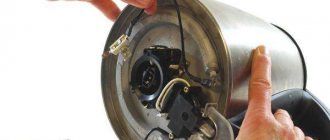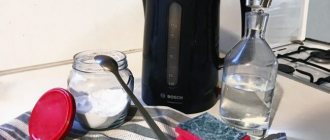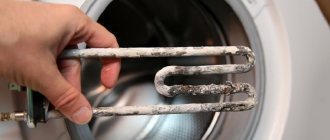The electric boiler was invented a long time ago and is extremely simple in its functionality. But in the modern world, program-controlled devices are already in use, which will not only boil water at a set time, but also maintain its temperature at a given level for quite a long time. Regardless of the simplicity or complexity of the design, any thing is subject to malfunctions. One of them is that the kettle turns off before the water boils. It is this problem and ways to eliminate it that will be discussed in this material.
How the kettle works
With a huge number of manufacturing companies, all kettles have the same electrical circuit. The differences can only be in the added little things. For example, now the device is often improved by installing a control module containing various timers. But, despite the additional indicators and backlights, the design of the device remains reasonably simple for any home craftsman to understand.
A modern electric kettle consists of two parts:
- stable stand with power cord;
- housing containing a flask with a heating element.
A durable cord supplies voltage to contacts hidden deep inside the stand to prevent accidental contact with the human body. The same contacts are located at the bottom of the device body. When the kettle is placed on the stand, the terminals are short-circuited, and the current travels further through the wires to the thermal switch, which operates in two modes:
- manual activation via a button on the frame;
- Automatic shutdown when liquid boils.
Important! There is also backup protection. It is constantly in the on mode and switches off only when you try to turn on an empty kettle.
After activating the switch, current flows to the heating element (tubular electric heater). The consumer will see the indicator light up, which informs that the device has started the boiling process.
After boiling, the steam hits the bimetallic plate in the thermal switch, where two different metals come into contact with each other. When heated by steam, one of the plates will bend and the contact will open. The device will disconnect from the network.
The kettle does not turn off when boiling
Modern electric kettles have firmly entered our everyday life, and the old ones have gone with a whistle into the past. Every morning a person starts by making tea or coffee. This tradition has entered our lives as an integral part. Coming to work in winter, everyone can warm themselves with warm tea. Even sitting and chatting with friends over a cup of hot drink is much more pleasant and comfortable for anyone.
What a disappointment a person feels when he turns on his favorite kettle early in the morning and, as always, goes to the bathroom, only to return to find a most unpleasant picture. The whole kitchen is in a white fog with steamy air, and the culprit of this incident is a favorite kettle that has never failed. You immediately ask yourself why he didn’t pass out, what happened to him.
Why the kettle did not turn off when boiling: the main reasons
Every owner of such household appliances wants to understand and figure out why the electric kettle does not turn off. You don’t want to immediately drag it into repair; it often happens that there is essentially nothing to repair.
- The funny thing is that the malfunction can be due to human inattention; this is a bad closure of the lid. The accumulated steam will come out one way or another. This effect leads to a banal failure of the shutdown system.
- Steam also comes out if the filter is poorly installed, it is uneven or completely absent. If it is uneven, the lid will not close tightly, it is impossible to prevent steam from escaping, and the shutdown mechanism does not work.
- One of the reasons that lead to the shutdown system not working is contamination of the device. Caring for household devices is a necessary condition for trouble-free operation. Therefore, it is necessary to clean the accumulated scale on the walls from time to time.
- For those who still have old models, the reason may be a blockage of the channel for the steam to escape. New brands, more improved for use. The developers took the problem into account and made some changes to the design of the device.
- If the switch malfunctions, there is no need to replace it.
- The reason may also be the breakdown of a special plate, which is designed to shut off the electrics when heating water. You can turn off the kettle yourself, but for safety it’s better to fix it.
- Oxidation of contacts, this does not require much intelligence; using sandpaper, the problem can be solved quickly.
Important! Not turning off household appliances largely depends on proper use and care. A breakdown can also be corrected with your own hands, only with some knowledge of the design of the device.
How to repair a kettle yourself
The first thing to do is inspect for any cracks or other damage. If the equipment on top is in good condition, look for the reason inside; perhaps the filter is installed incorrectly and this is one of the main breakdowns. Inspect for scale; if there is any, the deposit must be washed off. In older designs, check the steam vent. After a visual inspection and finding no visible faults, you must begin disassembling the household appliances.
- If the switch breaks down, it must be replaced with a new one; it cannot be repaired.
- The problem with the contacts can be solved quite easily, you just need to wipe them well with sandpaper and that’s it.
Having completed such repair work, reassemble the kettle sequentially, as you disassembled it. You can check it for correct assembly using water. We pour the liquid into the device and leave it on any fabric for about twenty minutes; if there are no traces of sputum, then the assembly of the unit was successful. Only then, connect the kettle to the power grid.
When to contact specialists
There are malfunctions that cannot be repaired at home and a call to a specialist is inevitable. If the microcircuit, switch, plate is faulty, it indicates improper use.
After consulting with a specialist, you need to determine whether it is worth repairing the device or whether it is more profitable to buy a new electric kettle. Estimating the cost of repairs and the price of a new device is not difficult. Of course, if it is more profitable to repair, then it is better not to abandon your old friend.
When you decide to buy new equipment, make the purchase as profitable as possible; high-quality branded equipment with a guarantee can last a long time and without breakdowns. But we must not forget that any household appliance requires proper handling.
The danger of a kettle that does not automatically switch off
Modern household appliances are designed by qualified specialists taking into account safety measures. Any household appliance is sold with detailed instructions for proper use; it cannot be neglected. Human safety depends on this.
If the automatic shutdown breaks down, there is a risk of fire, which has very negative consequences. Many users are accustomed to automation and can turn on the device to do their business in other rooms, but it is still unsafe.
A faulty container, when water boils unattended, is a time bomb. Gradually the water will boil away to zero point; if work stops, it will be happiness for the person. If work continues, a fire is guaranteed. Therefore, when using the device, pay attention to its complete serviceability.
Sources: https://rem.ninja/kuhnya/tehnika/chaynik-ne-otklyuchaetsya-posle-zakipaniya.html https://setafi.com/bytovaya-tehnika/chajnik/ne-otklyuchaetsya-chajnik-pri-zakipanii/ https ://electrosam.ru/glavnaja/jelektrooborudovanie/ustrojstva/termopot/
overheat protection
In backup protection, plates with different expansion coefficients act as temperature sensors. Having a special sample inside, the plates are glued together and fit tightly to the bottom of the kettle. They are helped in this by a paste with increased heat-conducting properties, which is applied to the surface. Under no circumstances should it be removed from the thermal protection switch.
Temperature sensor
Using a ceramic rod, the plate is connected to the contacts. When heated, one of the plates bends, the rod moves and opens the circuit. But then a gradual cooling occurs, and the rod closes the connection again. This action will continue in a circle until the heating element burns out or the kettle is removed from the stand. To prevent automatic switching on, backup protection is installed, which cuts off the voltage supply to the device.
Disassembling the electric kettle
To understand why the device turns off prematurely, it is necessary to partially or completely disassemble it, which will allow you to quickly find the faulty unit and repair it or completely replace it. The dismantling algorithm will be considered using the example of a kettle from a brand manufacturer - Bosch. At the bottom of its case there are four screws that need to be removed. To do this, select a screwdriver that matches the screw heads. A cross is usually suitable.
But recently, the manufacturer has begun to use protection against attempts at self-repair. For example, he can hide the bolts under plastic plugs, which can be easily pulled out by prying them with something sharp. Or use one screw (or all) with a non-standard head. Then you will need a two-pronged fork type screwdriver, which can be replaced with tweezers. You can also do it yourself by sawing a groove in the flat blade of a regular screwdriver with a needle file.
Advice! If the self-tapping screw does not want to unscrew, then the easiest and fastest way to deal with this problem is to heat it up a little by applying the switched-on soldering iron to the head. The plastic will soften slightly and the screw will come out easily.
The last level of protection is the clever latches on the case and the lid itself. There is an opinion that sometimes removing the cover is more difficult than making the repair itself. In this case, two thin screwdrivers will help. The first one is pushed under the lid to create a gap. And the second one in this gap is to find the place of the latch and carefully release it.
Important! After disassembling the electric kettle, be sure to check all wire connections for integrity. Loose contact can cause many problems, including early shutdowns.
How to disassemble the device for repair
To eliminate the cause of the malfunction of the electric kettle, it may be necessary to dismantle the device body. Manipulation allows you to repair or replace a failed technological unit.
On any model, the body parts are connected using mounting screws and latches. The work of dismantling the kettle comes down to unscrewing the screws and carefully pulling out the clever latches. Screws are usually located on the bottom of the case and at the bottom of the handle. Not all models have visible fasteners. Manufacturers practice tactics to protect devices from self-repair by using plastic covers and plugs with latches, and screws with non-standard heads. To dismantle the kettle, you will need thin flat and Phillips screwdrivers, tweezers, and a handy tool with a sharp end.
The sequence of manipulations for disassembling the device is as follows.
- Unscrew all the bolts located on the back of the kettle bottom. The number of fasteners depends on the device model. Bosch brand kettles use 4 mounting screws. If the bolts are hidden under a cover plate, you need to use a sharp object to pry it up and carefully remove the part without damaging the latch.
- On Vitek, Polaris, Scarlett and some other models, additional fixing bolts are located under the lining at the bottom of the handle. Using the same steps described above, you need to unscrew the screws.
- After removing all the fasteners, you need to carefully separate the parts of the body connected to each other: the bottom, the tank, the lid with the handle.
- The working components of the electric kettle: heating element, thermal relay, contact wires are located at the bottom of the body. The detected malfunction should be eliminated and the device reassembled in the reverse order.
Advice! When the screw is difficult to unscrew, you can slightly heat the head with a soldering iron. The plastic around the bolt will become slightly softer, which will allow you to unscrew it faster.
Main reasons for premature shutdowns
The main reason for this problem is the long service life of the boiling unit. Over many months of operation, a layer of scale and soot forms on the heater, which reduces heat transfer . Because of this, the heating element overheats, and, as a result, the protection mechanism is triggered. Even if there are only a few seconds left before the water boils, the thermostat turns off the device earlier, since it interprets this situation as a fire hazard.
Most often this happens with open-type heating elements. In such cases, you can carry out the repair yourself. And if in models with disk heaters it is enough to boil the flask with a solution of citric acid or vinegar several times, then the spiral must be removed and cleaned with a knife. You need to remove the plaque carefully, but at the same time being careful not to damage the coating of the element. Then the part should be wiped until shiny with a dry cloth. After this procedure, the heater becomes like new, the problems stop and the kettle continues to serve for a long time.
Due to age, the thermostat may not work correctly. After many years of regular expansion and contraction, the bimetallic strip becomes deformed and begins to turn off at the wrong time. Taking advantage of the fact that the protection is duplicated and both thermostats are identical, some masters swap them. Often this solves the problem.
Important! It is strongly not recommended to replace a faulty thermostat with a backup one yourself, as this may lead to a fire.
It's better to try to bend the plate into place. The measure, although temporary, is more reliable. Don't forget about low-quality Chinese stampings. The service life of such products is short, and, as a rule, they cannot be repaired.
Causes of failure
Now that the principle of operation is known, it is much easier to understand why the electric kettle stopped working and does not turn off on its own when it boils. There may be several reasons:
- The most common reason is that the lid is not closed, or is not closed tightly. Instead of steam moving through the channel, it will escape through the cracks to the outside. Because of this, the shutdown mechanism will not work.
- There is no filter or it is installed unevenly. Because of this, the lid does not fit very tightly to the edges. Gaps are formed through which steam escapes.
- If you don't take care of your kettle, scale will form over time. This will be immediately noticeable by the plaque inside.
- The steam outlet channel is clogged. This can happen in older models. In newer ones, the creators took this shortcoming into account.
- Breakage of the switch. Changes are mandatory without exception.
- Damage to the plate, which cuts off electricity when heated. Of course, in this case you can turn off the kettle manually. But it is still advisable to repair it to avoid fire or smoke.
- Contacts sticking. Simply wipe and clean the contacts with sandpaper to solve the problem.
Some of the reasons can be solved by prevention and proper care of the kettle. Descale, close the lid tightly, turn off the kettle during power surges and do not heat it many times in a row. For other faults, DIY repairs are possible. You just need to know what exactly to do.
Other reasons why an electric kettle turns itself off
If the above is not related to the problem, and the kettle still turns off without boiling, then the problem may be due to the following breakdowns.
- A faulty switch where the contacts can burn due to poor connections. And he himself may turn out to be defective. To check this, the button must be disconnected and the wires connected directly. If everything works, then, without a doubt, the switch should be replaced with a new one. Often you don’t even need to disassemble the kettle to do this. A few cases when the button does not snap back are enough to replace it.
- Liquid leakage from the flask, which most often affects plastic and glass water containers. Accordingly, metal flasks are much more reliable (they are often used as a thermos). Even a few drops of leaking water can affect the operation of the device. At home, you can only change the rubber gasket on the bottom between the body of the kettle and the compartment with the heating element.
- Broken electrical wiring contacts. When disassembling, having reached the heating element, you should carefully inspect the contacts at the junction of the wires. Their violation contributes to loose attachment of the heater to the body. If the heating element is an open type at home, it is not difficult to solve the problem yourself by cleaning the contacts and high-quality insulation.
- Thermal fuse is broken. Many models have additional protection in the form of a thermal fuse. It is needed in case the device does not turn off for some reason after the thermostat is activated. Typically, contact opening occurs at temperatures above 100 degrees Celsius. But if the thermal fuse is faulty, then it can operate at lower settings, thereby preventing the water from boiling.
When to take it to the master
It is not recommended to undertake DIY repairs if:
- insufficient knowledge, experience and self-confidence;
- The thermostat needs to be repaired or replaced;
- you need to repair the crack in the flask body;
- We have to work with a closed-type heating element.
Advice! In such cases, contact a service workshop.
Water in a faulty kettle does not boil completely for many reasons. And only the user can decide whether to repair it himself, take it to a workshop, or buy a new one.










